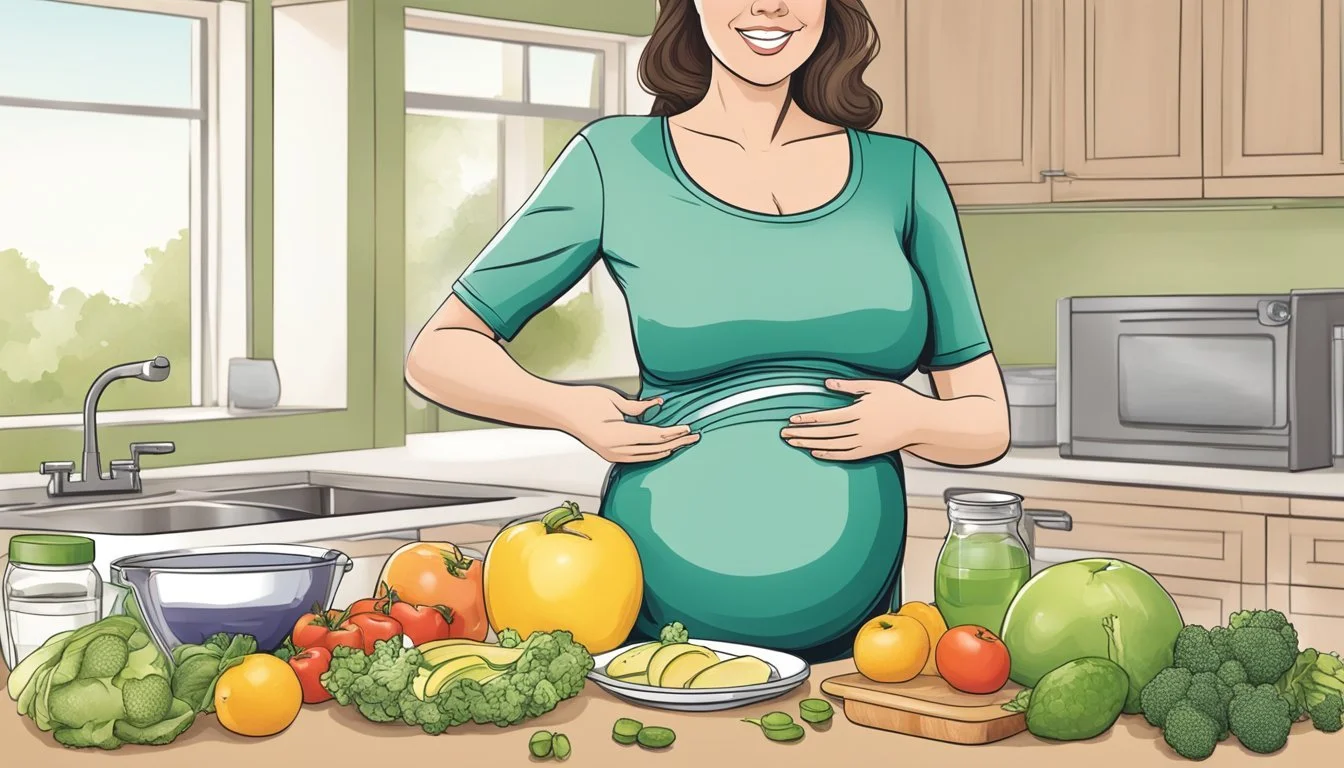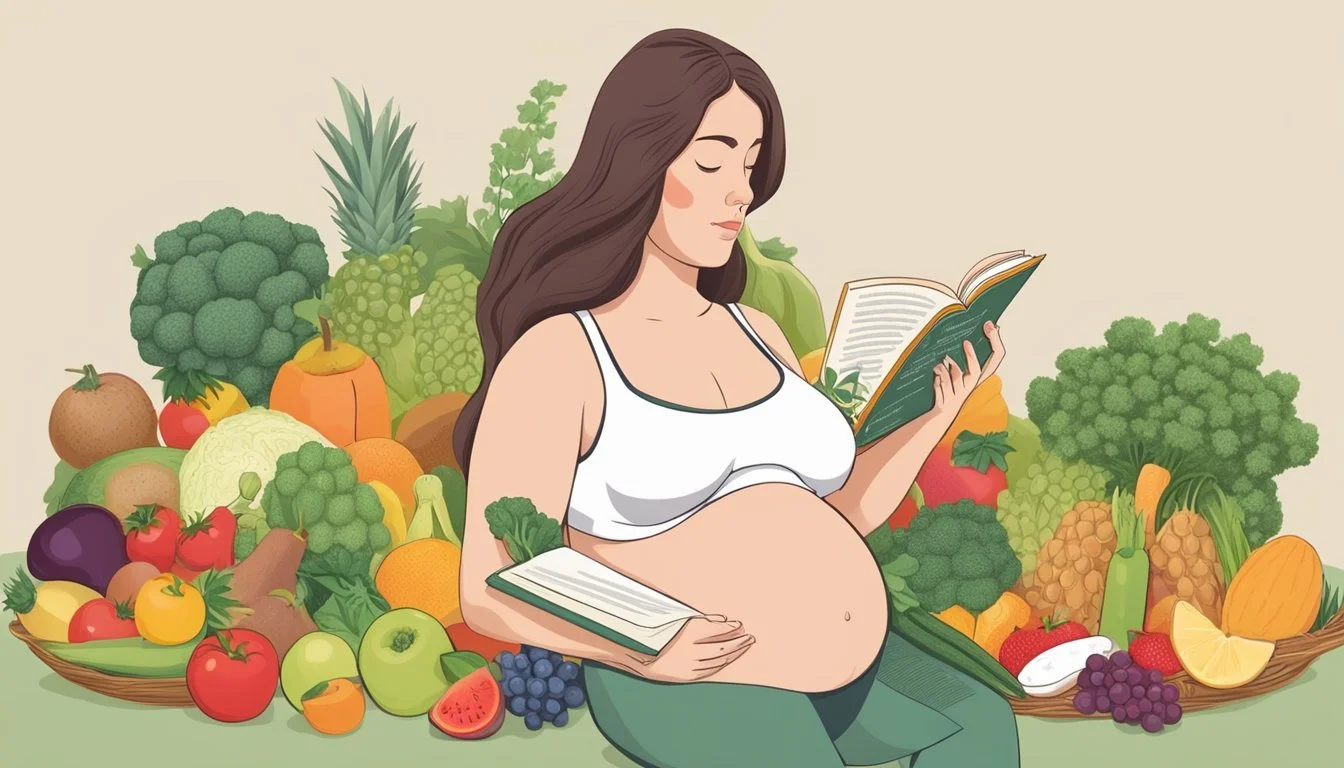Is It Safe to Follow the Pritikin Diet While Pregnant?
Evaluating Nutritional Adequacy
The Pritikin Diet, a plan emphasizing whole, unprocessed foods that are low in fat and high in fiber, garners attention for its potential health benefits. With a distinct distribution of calories—10-15% from fat, 15-20% from protein, and 65-75% from carbohydrates—it aims to improve overall heart health and reduce risks associated with lifestyle diseases. When considering pregnancy, a period demanding heightened nutritional awareness, the safety and adequacy of any diet become even more critical.
Adopting dietary patterns that support maternal health and fetal development is essential during pregnancy. While the Pritikin Diet is recognized for being nutritionally sound, providing abundant fruits, vegetables, whole grains, and legumes, its suitability for pregnant women requires a closer examination. These food groups align with the increased demands for nutrients such as folic acid, which is vital for preventing neural tube defects in the developing fetus.
The prevailing view among experts suggests that the Pritikin Diet poses no inherent risks if followed correctly and may be safely adopted by various populations, including pregnant women. However, due to the unique nutritional requirements during pregnancy, adaptations to the standard Pritikin Diet plan may be necessary to meet the increased needs for specific nutrients that support a healthy pregnancy outcome. It is always recommended that individuals, especially those who are pregnant, consult with healthcare professionals before embarking on any new diet to ensure that their individual health needs are met.
The Pritikin Diet Basics
The Pritikin Diet is designed to promote overall health through a diet rich in plants and complex carbohydrates, paired with a lifestyle that includes daily exercise. This dietary pattern is known for its low-fat, high-fiber characteristics.
Core Principles
The core of the Pritikin Diet lies in the consumption of unprocessed or minimally processed foods. It emphasizes the intake of a variety of fruits and vegetables, which are key contributors to its high fiber content. The diet also advocates for a reduction in saturated fat and cholesterol intake, which aligns with its principles for heart health.
Low-Fat: One strives for a diet that is low in fat, especially fats that are high in cholesterol and saturated fat.
High-Fiber: A high intake of dietary fiber from whole foods like fruits, vegetables, and whole grains is encouraged.
Key Components
The key components of the Pritikin Diet include:
Whole Grains: Foods such as whole-wheat bread, brown rice, oatmeal, and other unrefined grains form the foundation of the carbohydrate intake.
Vegetables and Fruits: A variety of both, emphasizing colorful variety, to supply vitamins, minerals, and antioxidants.
Beans and Legumes: Integral for their protein and fiber content, which support sustained energy levels.
Nuts and Seeds: Though included, they are recommended in moderation due to their high-fat content.
Protein: The primary sources are from legumes, beans, and lean sources of animal protein, with limited consumption of red meat.
Calcium: Adequate calcium intake is ensured through low-fat dairy options or fortified plant-based alternatives.
Healthy Fats: Emphasizes the importance of consuming fats that are primarily unsaturated, such as those found in certain fish, avocados, and olive oil.
The intent of this diet is not only to manage weight but also to foster an environment in the body that is less prone to disease, leveraging nutrition for robust health.
Benefits of Pritikin Diet During Pregnancy
During pregnancy, adopting a diet that is rich in nutrients and low in unhealthy fats can provide significant health benefits for both the mother and the baby. The Pritikin Diet, which highlights whole foods and a variety of nutrients, can be particularly beneficial during this time.
Nutrient Intake
The Pritikin Diet emphasizes whole, unprocessed foods that are naturally high in essential vitamins and minerals, which are crucial for the development of the fetus. Pregnant individuals who follow this diet typically consume:
Leafy greens and other vegetables, providing folic acid, which is vital for preventing neural tube defects.
Complex carbohydrates like whole grains and starchy vegetables, offering a steady supply of energy and fiber.
Calcium-rich foods such as fat-free dairy or alternatives, supporting bone development in the fetus.
Healthy Weight Management
Maintaining a healthy weight is vital during pregnancy, and the Pritikin Diet promotes:
Appropriate calorie intake through portion control and consumption of nutrient-dense foods.
Regular intake of fiber, which can aid in digestion and prevent excessive weight gain by inducing satiety.
Reduced Risk of Pregnancy Complications
A diet low in unhealthy fats and high in fiber, like the Pritikin Diet, can help in:
Lowering blood pressure and improving heart health, which is crucial because pregnancy puts extra strain on the heart.
Reducing the risk of gestational diabetes through the consumption of whole foods and complex carbohydrates, managing blood sugar levels effectively.
Considerations for Pregnant Women on Pritikin Diet
Pregnancy requires a careful balance of nutrients to support both the mother's health and fetal development. For those considering the Pritikin Diet during pregnancy, particular attention must be given to ensure caloric and nutrient needs are met.
Caloric and Nutrient Adjustments
Pregnant women require increased calories to support fetal growth, particularly in the second and third trimesters. The Pritikin Diet focuses on low-fat, high-fiber foods, which can be naturally lower in calories. It is essential for pregnant women to:
Consume adequate calories to meet the demands of pregnancy.
Adjust the diet to include a variety of nutrient-dense foods to ensure an appropriate intake of vitamins and minerals.
Adequate Protein Intake
Proper protein intake is crucial for fetal development. While the Pritikin Diet recommends approximately 15-20% of calories from protein, pregnant women might need to:
Monitor their protein intake to ensure they meet the recommended dietary allowance of 0.8 grams per kilogram of body weight, which may increase during pregnancy.
Include sources of protein such as egg whites, legumes, and fat-free dairy or substitutes to meet these needs.
Inclusion of Prenatal Vitamins
Prenatal vitamins are an essential complement to any pregnancy diet to fill nutritional gaps. Women following the Pritikin Diet should:
Ensure their prenatal vitamins include folic acid, iron, calcium, and vitamin D—critical nutrients for fetal development.
Discuss with healthcare providers the best prenatal vitamin options that align with their dietary patterns.
Food Safety and Pregnancy
When pregnant, ensuring food safety is crucial as it impacts both maternal and fetal health. Women must be mindful of possible contaminants like listeria and mercury that can be present in certain foods and adhere to safe food handling practices to reduce risks.
Risk of Listeria and Mercury Exposure
Listeria is a significant foodborne pathogen that can cause listeriosis, especially concerning in pregnancy due to potential complications such as miscarriage or stillbirth. Pregnant women should avoid high-risk foods known to harbor listeria, such as soft cheeses including brie and feta, unless they are clearly labeled as made with pasteurized milk. Additionally, deli meats and hot dogs should be heated until steaming hot to kill any potential bacteria.
Exposure to mercury is another concern during pregnancy, primarily through the consumption of certain types of fish that accumulate mercury in their bodies. High levels of mercury can affect the developing brain and nervous system of the fetus. It is advisable for pregnant women to avoid high-mercury fish like swordfish, shark, king mackerel, and tilefish. Conversely, low-mercury fish, such as salmon, sardines, and freshwater trout, can be consumed in moderation and provide beneficial omega-3 fatty acids.
Safe Food Handling Practices
Employing safe food handling practices is key to preventing foodborne illnesses during pregnancy. Pregnant women should:
Cook seafood thoroughly: Fish should be cooked to an internal temperature of 145°F, and shellfish, such as oysters, clams, and mussels, should be cooked until their shells open fully.
Separation of raw and cooked foods to prevent cross-contamination.
Cleanliness: Regularly wash hands, as well as surfaces and utensils that come into contact with food.
Storage: Perishable items should be refrigerated promptly. Hot dogs and deli meats, for instance, need to be stored at safe temperatures and consumed before their expiry dates.
By following these guidelines, pregnant women can significantly decrease the risks associated with foodborne illnesses and contribute to a healthier pregnancy.
Tailoring the Pritikin Diet For Pregnancy
Pregnancy demands specific nutritional requirements to support both the mother's and developing baby's health. Adhering to the Pritikin Diet, one can align these needs with a focus on omega-3 fatty acids, iron, and calcium without compromising the principles of this low-fat, high-fiber diet.
Incorporating Omega-3s and Iron
The Pritikin Diet typically includes low-fat protein sources, which can be enhanced during pregnancy by adding omega-3-rich foods such as flaxseeds and walnuts. It's also crucial to increase iron intake to support fetal development and prevent anemia. Iron can be sourced from beans, legumes, and fortified whole grains like oatmeal.
Omega-3 Sources: Flaxseeds, walnuts
Iron-Rich Foods: Beans, lentils, fortified grains
Focusing on High-Fiber Foods
High-fiber foods are essential for maternal health, providing sustained energy and aiding in digestion. Include a variety of whole grains like brown rice and oatmeal alongside fiber-packed beans and legumes. These foods, base staples of the Pritikin Diet, also contribute to the needed iron and other nutrients.
Whole Grains: Oatmeal, brown rice
Beans and Legumes: Chickpeas, black beans
Adjusting for Increased Calcium Needs
Calcium requirements increase significantly during pregnancy. It's important to incorporate calcium-rich foods within the Pritikin framework. Focus on fat-free or low-fat dairy products if tolerated and calcium-fortified plant milks. Non-dairy options include leafy greens, nuts, and seeds.
Dairy and Dairy Alternatives: Skim milk, calcium-fortified almond or soy milk
Calcium-Rich Foods: Kale, almonds, chia seeds
By carefully choosing foods within these categories, the Pritikin Diet can be tailored to meet the nutritional demands of pregnancy, ensuring adequate intake of critical nutrients while maintaining a heart-healthy eating pattern.
Potential Challenges of Pritikin Diet in Pregnancy
When pregnant, a woman's body requires additional calories and specific nutrients to support fetal development. The Pritikin Diet's low-fat and high-fiber focus could provide challenges in meeting these heightened nutritional demands during pregnancy.
Meeting Increased Caloric Needs
During pregnancy, a woman typically needs to consume more calories to sustain both her body and the growing fetus. The Pritikin Diet, known for being low in calories, may make it difficult to achieve the necessary caloric intake. Pregnant women typically require an additional 300-500 calories per day during the second and third trimesters, depending on their pre-pregnancy weight.
Restrictions and Food Cravings
The diet restricts consumption of several food groups like dairy, meat, poultry, and fish to varying degrees, favoring a plant-based approach. Pregnant women often experience food cravings, and the limited choices on the Pritikin Diet might cause frustration or lead to decreased adherence. Moreover, certain cravings can indicate nutritional needs, such as a craving for dairy, which could signal a need for more calcium.
Ensuring Sufficient Fat Intake
Fat consumption is another consideration. The Pritikin Diet prescribes a low intake of fats, with a particular focus on reducing saturated fats found in foods like meat and full-fat dairy products. However, fats are essential during pregnancy for the development of the baby's brain and nervous system. Pregnant women should ensure they are getting enough healthy fats, including those from nuts, seeds, fish, and oils, while monitoring the intake of saturated fats.
Incorporating a variety of proteins from nuts, seeds, and legumes, along with an emphasis on foods rich in omega-3 fatty acids like certain fish, can help achieve a well-rounded diet while managing fat intake recommendations.
Supplementation and Special Nutrients
During pregnancy, the need for certain nutrients increases to support fetal development. The Pritikin diet, with its emphasis on natural, whole foods, may require supplemental intake of key nutrients to ensure that both mother and baby's nutritional needs are met.
Importance of Folate and Vitamin D
Folate is crucial in pregnancy to prevent neural tube defects. Women should aim for at least 600 micrograms per day, which may come from prenatal vitamins or fortified foods. Natural food sources such as leafy greens should be a part of the diet, but supplementation is often recommended to reach the necessary levels.
Vitamin D plays a vital role in bone health and immune function. Pregnant women are advised to get 600 IU daily. While the Pritikin diet includes vitamin D sources like fortified dairy products and certain fish, the limited sun exposure or dietary restrictions may necessitate additional vitamin D supplements.
Iron and Calcium Supplementation
Women need more iron during pregnancy to support increased blood volume and fetal growth. The recommended intake is 27 milligrams per day. Since the Pritikin diet is low in fat and may not include as many iron-rich animal products, supplemental iron might be needed alongside consumption of iron-rich plants such as legumes and leafy greens, which should be paired with vitamin C-rich foods to enhance absorption.
Calcium is essential for fetal bone and teeth development. The recommended intake is 1,000 milligrams per day, which can be challenging to meet without consuming dairy products or calcium-rich leafy greens. If the Pritikin diet's natural sources are insufficient, a calcium supplement may be necessary to reach the required amounts.
Dietary Inclusions and Exclusions
When following the Pritikin diet during pregnancy, it is essential to consider which foods are included and which are excluded to ensure a balance of nutrients for both the mother and the developing baby.
Fruits and Vegetables
The Pritikin diet emphasizes a high intake of fruits and vegetables, recommending at least five servings of vegetables and four servings of fruit each day. These foods provide essential vitamins, minerals, and fiber. Pregnant women should focus on a variety of colorful fruits and vegetables to maximize nutrient content.
Fruits: berries, apples, pears, bananas, citrus fruits
Vegetables: leafy greens (spinach, kale), cruciferous veggies (broccoli, cauliflower), and other variety of colorful vegetables
Whole Grains and Starchy Vegetables
Whole grains are a cornerstone of the Pritikin diet, offering essential nutrients and sustainable energy. Pregnant women are encouraged to choose whole, unprocessed grains.
Whole grains: whole-wheat bread, brown rice, quinoa, oatmeal
Starchy vegetables: potatoes, corn, yams
These foods provide complex carbohydrates, which are crucial for energy needs during pregnancy, as well as fiber for digestive health.
Meat, Fish, and Alternatives
Protein is crucial during pregnancy, and the Pritikin diet allows for lean animal proteins as well as plant-based alternatives. It is important to choose lower-fat options and prepare them using methods like grilling, baking, or steaming rather than frying.
Meat: Opt for lean cuts of poultry.
Fish: Focus on omega-3 rich fish such as salmon, but be mindful of mercury levels and consume in moderation.
Vegetarian/Vegan Alternatives: Legumes (beans, peas, chickpeas, and lentils), nuts, and seeds are excellent plant-based sources of protein.
It's essential for pregnant women to consider these options to meet their increased protein needs while following the Pritikin dietary guidelines.
Designing a Pritikin-Compatible Meal Plan
When crafting a meal plan that aligns with the principles of the Pritikin diet, one must focus on whole, plant-based foods, and minimize the intake of processed foods and animal products. A balance of complex carbohydrates, fiber, and lean proteins is essential.
Sample Meal Ideas
Breakfast:
Oatmeal with sliced bananas, strawberries, and a sprinkle of cinnamon.
Whole grain toast topped with avocado and a serving of scrambled egg whites.
Lunch:
Lentil salad with a variety of chopped vegetables such as bell peppers, cucumbers, and tomatoes, dressed with lemon juice and herbs.
Quinoa bowl with black beans, corn, fresh salsa, and greens like spinach or kale.
Dinner:
Grilled vegetable kebabs with small portions of tofu or tempeh.
Steamed brown rice alongside a stir-fry of Asian greens, mushrooms, and snap peas with ginger and garlic.
Snacks and Treats
Snacks:
Fresh fruit like apple slices, a cup of berries, or orange segments.
Raw vegetables such as carrot sticks or cherry tomatoes paired with hummus.
Treats:
A small portion of dark chocolate (at least 70% cocoa).
Baked pear or apple, spiced with nutmeg and cinnamon, for a sweet dessert option.
Incorporating a diverse array of vegetables, fruits, whole grains, and legumes while limiting processed foods, high-fat dairy, and excessive sugars honors the Pritikin diet's guidelines. Small amounts of nuts and seeds can also be included for added nutrients and healthy fats. It's crucial to tailor the meal plan to meet the increased nutritional needs during pregnancy, ensuring both the mother's and baby's health.
Exercise and Physical Activity Recommendations
Pregnant individuals considering the Pritikin diet must also pay attention to exercise—a key component alongside dietary habits. The Pritikin Program recommends daily physical activity as it contributes to overall health and can aid in weight management, which is crucial during pregnancy.
Moderate exercise is generally encouraged for its multiple health benefits, including:
Improved cardiovascular health
Reduced risk of gestational diabetes
Lowered inflammation levels
However, each individual's situation is unique, and any exercise regimen should be discussed with a healthcare provider. Specifically tailored activities ensure safety and efficacy, particularly when managing weight and health during pregnancy.
Here are typical exercise recommendations for pregnant individuals, which the Pritikin Program aligns with:
Daily Exercise: Aim for at least 30 minutes of moderate-intensity exercise most days of the week.
Type of Exercise: Focus on low-impact activities such as walking, swimming, or prenatal yoga.
Intensity: Keep intensity moderate; one should be able to carry on a conversation during the activity.
The regimen should not be overly strenuous and must prioritize the individual's well-being above all. Regular monitoring of intensity is vital—excessive exertion can be detrimental to both the pregnant individual and the fetus. Overall, exercise during pregnancy should be balanced with proper dietary habits for optimal health outcomes.
Monitoring Health and Diet Outcomes
In managing health and nutrition during pregnancy, consistent monitoring is crucial. The Pritikin diet, with its focus on a low-fat, high-fiber menu, can influence weight management, blood pressure, and cholesterol levels.
Regular Check-Ups and Feedback
Pregnant individuals should schedule regular check-ups with their healthcare provider to monitor the impact of their diet on both maternal and fetal wellbeing. Key metrics like weight, blood pressure, and cholesterol levels offer crucial feedback. For example:
Weight Gain: Should align with the guidelines for a healthy pregnancy weight.
Blood Pressure: Ideal maintenance of healthy levels may prevent gestational hypertension.
Cholesterol: Monitoring ensures levels stay within a safe range to avoid complications.
Adapting the Diet as Needed
As pregnancy progresses, dietary needs may change. It's important to adapt the diet to meet the nutritional demands of both the mother and developing fetus. Some adaptations might include:
Increasing Intake: Certain nutrients like folic acid, iron, and calcium may need to be increased.
Modifying Portions: If weight management becomes a concern, portions can be adjusted accordingly.
Adaptations should always be done under the guidance of a registered dietitian or healthcare provider to ensure that any changes continue to support optimal maternal and fetal health outcomes.












